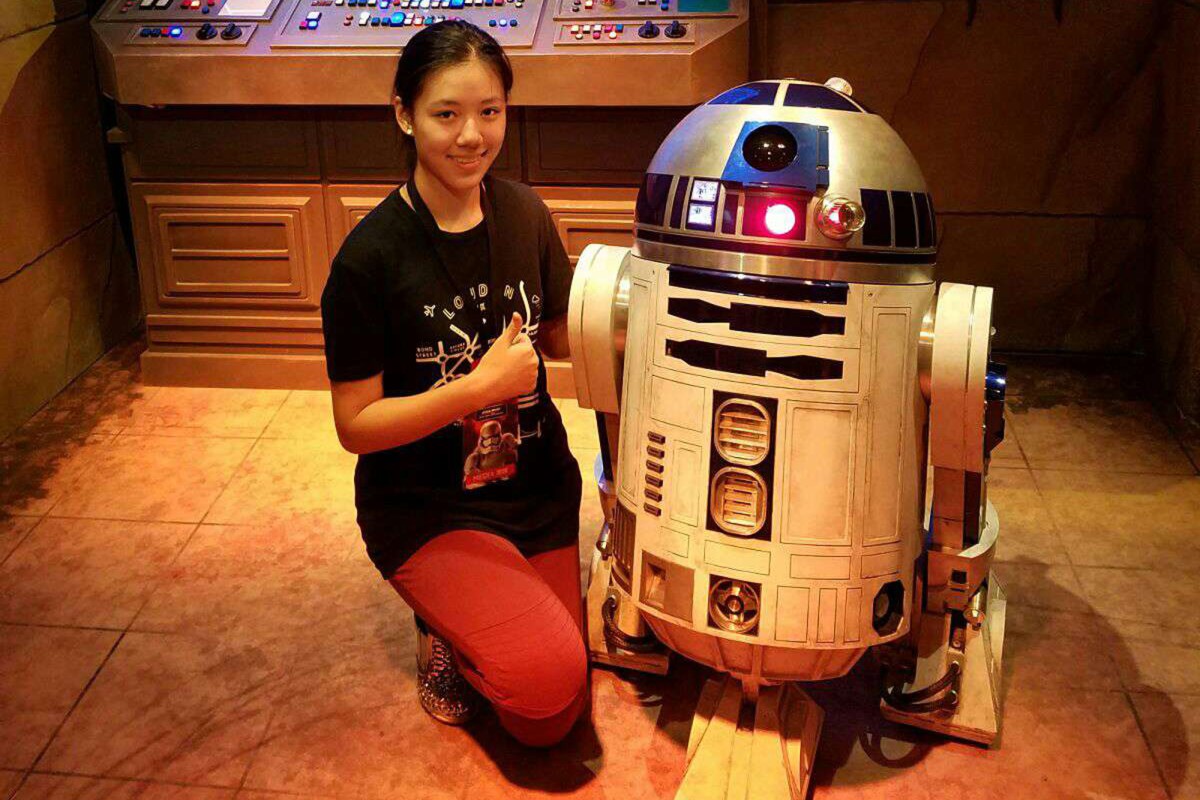
From interviewing a princess to chatting with Chewbacca: what it's really like as a YP cadet
Work experience at Young Post is intense, challenging and utterly amazing
 Live reporting for YP at Disney on Star Wars. The little guy next to her is R2-D2.
Live reporting for YP at Disney on Star Wars. The little guy next to her is R2-D2. As I walked into Young Post headquarters in Tai Po, there was only one thought running through my head: how am I supposed to find a coffee pot in an office this big? My friend, who had introduced me to the programme, had warned me that the only job for cadets was to make coffee for the editor each morning.
After applying for a spot multiple times throughout the past two years, I finally succeeded on my third attempt. After my friend’s advice, I thought I knew what I was getting myself into.
So, just imagine the shock on my face when Susan, the Young Post Editor, sat me down on my first day and talked to me about nut graphs and how I could use them to pitch my story ideas to her - making sure to keep it to three lines, please.
I quickly learned that as well as never having to make the coffee, I would have a lot of important work to do, including conducting interviews and writing articles.
Where the magic happens
Having participated in more than a dozen editorial meetings, where nut graphs are discussed, I must say that they turned out to be my favourite moments in the office. As cliché as it may sound, this really is where all the magic begins, as everyone shares their story ideas. Initially, they are just raw ideas, but during the meeting they are discussed by everyone to decide whether it’s an interesting, useful story for Young Post readers, and what the angle should be.
I learned it’s not only important to include the basics, such as the five Ws (who, what, when, where and why), but also to have properly researched the subject. Even though this information might not be in my nut graph, it will give the team a better understanding of the story.
For instance, when I pitched a story about Peking duck, I also came up with questions I might be asked: has this story been written about before? If yes, do I have a new angle for it? What is the selling point of this article? How does Peking duck in Beijing differ from that in Hong Kong? Will teenagers like myself be willing to read a story like this?
With answers at the ready, I could go into the meetings feeling confident and prepared.
The eyes of a journalist
As exciting as the editorial meetings are, face-to-face interviews are at the heart of journalism. Doing interviews taught me to treat each feature story like a blank piece of paper, which should not be touched before speaking to interviewees.
For this reason, two of my most memorable interviews were the one with a sex worker, and the one with Julien, who lost his vision as a teenager. The interview with a sex worker was hard as society has instilled in me such a negative perception of them. Likewise, it was almost impossible for me to let go of the sympathy I felt towards the visually-impaired when I spoke to Julien. These emotions and preconceptions make it difficult to treat the interviewees, or their stories, with the objectivity required to write a balanced article.
However, at the end of each interview, instead of seeing someone who had sold her body and lost her dignity, I saw a struggling mother doing everything she could to help her child; instead of seeing someone who is handicapped and needed help, I saw an empowering individual who has transcended all the limitations of life and is doing his best to help others.
On another occasion, I also got to meet royalty, in the form of Princess Aisha of Bhutan. So much for just making coffee!
Live reporting
Another highlight of my time at Young Post cadet has to be live reporting. I covered three different events, and it taught me a lot.
It is such an exhilarating and demanding task that requires a lot of hard work and preparation. As I had previously learned during a live reporting workshop offered by Young Post, it makes things easier on the day if I have prepared as much as possible in advance, so all I have as much as I need if and when I need it.
But despite being prepared, the ability to react and adjust to different unexpected situations is key to live reporting. Having discovered that opportunities are all around me, I realised that I shouldn’t forget to focus on seemingly-trivial details while keeping an eye on the big picture.
Live reporting also taught me to grow a thick skin, to avoid getting pushed around by the professional reporters in the heat of the moment.
By combining everything I learned from editorial meetings, interviews, live reporting and my time in the office, I not only survived, but thrived during my time as a Young Post cadet.
